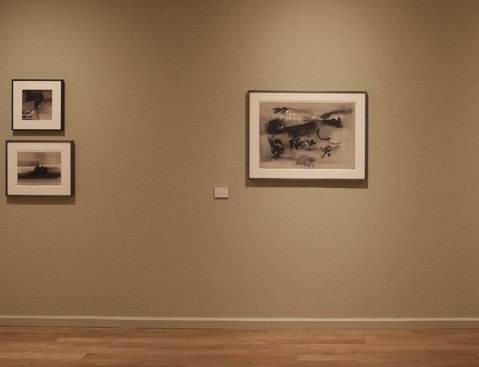
A black arched window floats in a white quadrangle of wall. Even in a room crowded with spectators – as the Kiran Nadar Museum of Art was on the opening night of Nasreen Mohamedi’s show – the photograph compels attention. It is structured out of essences: curve, line, black, white, light, shadow. It unifies strands that usually remain separate: the Islamic arabesque and the Constructivist square, a monochrome asceticism and a silvery dazzle. It reverses expectations – the black is bright and eloquent; the white opaque and silent – yet also has the distilled clarity of the last word on colour, architecture, geometry and ways of seeing them. It is rare today to find an artist whose work genuinely stills the gaze. But Mohamedi is one such. Born in Karachi in 1937, when it was still part of India, she lived in Mumbai before studying art in London and Paris. In the early 1960s she returned to India before settling in Baroda in 1972 to teach at the fine arts department of the MS University. By then her journey was mapped. Drawing was her medium (she never recognised her photographs as part of her oeuvre). Fortunately, her estate thinks otherwise and this show shimmers with Mohamedi’s black-and-white prints. They are formidable, flashing insights into the world around her: the diagonal encounter between pavement and tower block; the white-on-black road marking; the brutalist concrete steps on the far border of a public square. Curated by Roobina Karode, this exhibition is blessed with quotations from Mohamedi’s diaries – “The Maximum out of the Minimum”; “Circular depths/Textures of Edges/To study circular depths and depression” – that express a condensed curiosity about the metaphysics of the material world. Allied to the obsessive drawing, they bring Leonardo to mind. The 1960s brought juvenile experiments: ink and watercolour forays into landscapes and the figure; a spattering of black ink that recalls Mathieu. Quickly however, she embraced the monochrome geometries essential for an artist in pursuit of silence, infinity and invisible structure. By the mid-1970s, her path lay through the grid. The lines in this work are straight and slanted; thick and thin; light and dark. Hypnotic, stuttering graphs bring Agnes Martin to mind but others express a tension between void and volume that owes more to eastern mysticism. Mohamedi was absorbed by Zen, Tao and Sufism. Her gift was for straddling the space between those wisdoms and western Utopian abstractionists such as Mondrian and Malevich. She was heir to a lineage of Indian abstraction too, its guiding light the Mumbai artist VS Gaitonde. Mohamedi died in 1990 of a neuromuscular disease that devastated her body yet left her with control of her drawing hand. In the last decade of her life a fearless formalism saw her jettison the grid in favour of solitary, geometric constellations of line and shadow that float in whiteness with an urgent purity to which El Lissitzky could only aspire. Why is she not better known? She is not unshown; recent outings include Documenta 2007, New York’s Drawing Center in 2005; and Milton Keynes Gallery in 2009. Eurocentrism must play its part. But probably it is the fashion for art that is fabulous, fast and forgettable that has made us deaf to Mohamedi’s quiet, eternal truths. It is time to remedy our loss.
-Rachel Spence